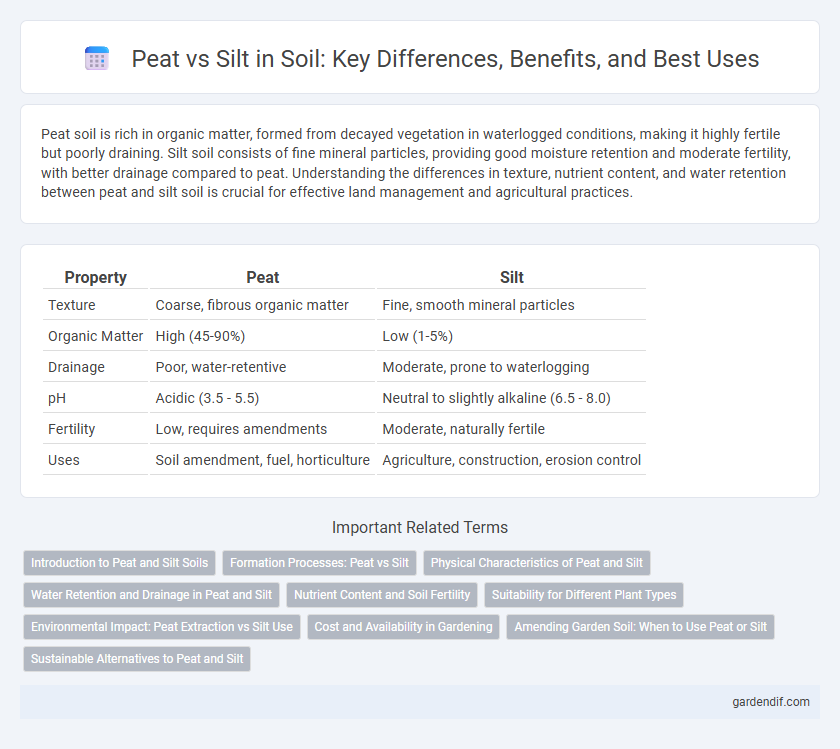
Peat vs Silt Illustration
Peat soil is rich in organic matter, formed from decayed vegetation in waterlogged conditions, making it highly fertile but poorly draining. Silt soil consists of fine mineral particles, providing good moisture retention and moderate fertility, with better drainage compared to peat. Understanding the differences in texture, nutrient content, and water retention between peat and silt soil is crucial for effective land management and agricultural practices.
Table of Comparison
| Property | Peat | Silt |
|---|---|---|
| Texture | Coarse, fibrous organic matter | Fine, smooth mineral particles |
| Organic Matter | High (45-90%) | Low (1-5%) |
| Drainage | Poor, water-retentive | Moderate, prone to waterlogging |
| pH | Acidic (3.5 - 5.5) | Neutral to slightly alkaline (6.5 - 8.0) |
| Fertility | Low, requires amendments | Moderate, naturally fertile |
| Uses | Soil amendment, fuel, horticulture | Agriculture, construction, erosion control |
Introduction to Peat and Silt Soils
Peat soil consists primarily of decomposed organic matter and retains high moisture content, making it rich in nutrients but often acidic and poorly drained. Silt soil, composed of fine mineral particles, offers better drainage and fertility compared to clay while maintaining moisture retention superior to sand. Understanding the distinct properties of peat and silt soils is essential for effective soil management and crop selection in agriculture and horticulture.
Formation Processes: Peat vs Silt
Peat forms primarily in waterlogged, anaerobic environments where the slow decomposition of plant material leads to the accumulation of organic matter. In contrast, silt originates from the mechanical weathering and erosion of rocks, with fine mineral particles transported by wind or water and deposited in sedimentary layers. The slow biological buildup in peat contrasts sharply with the physical sediment deposition process characteristic of silt formation.
Physical Characteristics of Peat and Silt
Peat soil is characterized by high organic matter content, low bulk density, and a spongy texture that retains significant moisture, making it highly compressible and acidic. In contrast, silt soil consists of fine mineral particles, feels smooth and floury, has moderate water retention, and exhibits better drainage than peat. The physical structure of peat promotes waterlogging, whereas silt facilitates aeration and nutrient availability for plant roots.
Water Retention and Drainage in Peat and Silt
Peat soil exhibits high water retention due to its organic matter content and porous structure, making it ideal for moisture-loving plants but prone to poor drainage and waterlogging. In contrast, silt soil has moderate water retention with finer particles that hold water longer than sand but drain more effectively than peat, supporting plant roots without excessive moisture buildup. Understanding these water retention and drainage characteristics helps optimize soil selection for agricultural and horticultural applications.
Nutrient Content and Soil Fertility
Peat soil is rich in organic matter, providing high nutrient content that supports plant growth but often has low pH, which can limit nutrient availability. Silt soil, composed of fine mineral particles, has moderate nutrient content and excellent water retention, enhancing soil fertility and root development. While peat improves soil structure and moisture, silt offers better aeration and nutrient-holding capacity, making both valuable but distinct for agricultural use.
Suitability for Different Plant Types
Peat soil, rich in organic matter and moisture retention, is ideal for acid-loving plants like blueberries, azaleas, and rhododendrons that require consistent moisture and low pH levels. Silt soil, characterized by fine particles and good fertility, supports a wide range of plants including vegetables, fruits, and flowers due to its balanced drainage and nutrient availability. Understanding the moisture and pH preferences of plants helps determine whether peat or silt soil is more suitable for successful growth.
Environmental Impact: Peat Extraction vs Silt Use
Peat extraction significantly disrupts carbon storage, releasing large amounts of carbon dioxide and contributing to greenhouse gas emissions. In contrast, silt use in agriculture and land reclamation tends to enhance soil fertility and structure without depleting natural carbon reserves. Sustainable management of silt promotes biodiversity and reduces environmental degradation compared to the high ecological cost of peat harvesting.
Cost and Availability in Gardening
Peat is widely available and often more expensive due to its harvesting and environmental regulations, while silt is generally cheaper and easier to source locally in gardening contexts. Peat provides excellent moisture retention but its cost can be a limiting factor for large-scale use. In contrast, silt offers moderate nutrient content and drainage benefits at a lower price, making it a cost-effective choice for budget-conscious gardeners.
Amending Garden Soil: When to Use Peat or Silt
Peat is ideal for acidifying garden soil and improving moisture retention due to its high organic matter content and ability to hold water, making it suitable for plants like blueberries and azaleas. Silt enhances soil structure by increasing fertility and drainage without drastically altering pH, benefiting vegetables and flowers that prefer neutral to slightly alkaline conditions. Use peat in sandy or acidic soils needing moisture retention and silt in clay-heavy or compacted soils to boost aeration and nutrient availability.
Sustainable Alternatives to Peat and Silt
Sustainable alternatives to peat and silt in soil management include coconut coir, composted bark, and biochar, which enhance water retention and nutrient availability without depleting natural peatlands or causing sedimentation issues from silt runoff. Utilizing these alternatives helps reduce carbon emissions linked to peat extraction and mitigates soil erosion commonly associated with silt-heavy soils. Adopting organic mulches and soil conditioners derived from renewable sources supports long-term soil health and biodiversity conservation.
Peat vs Silt Infographic

 gardendif.com
gardendif.com